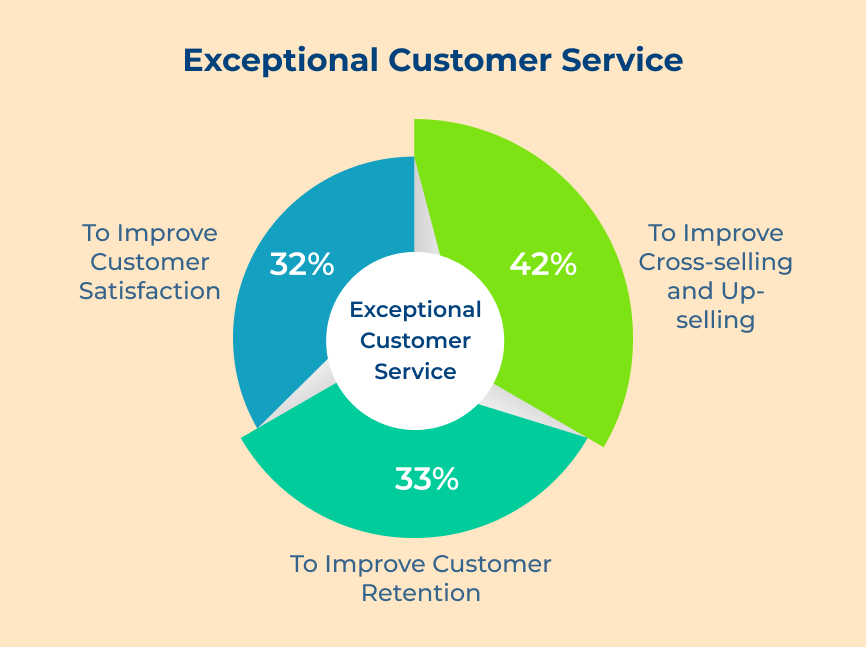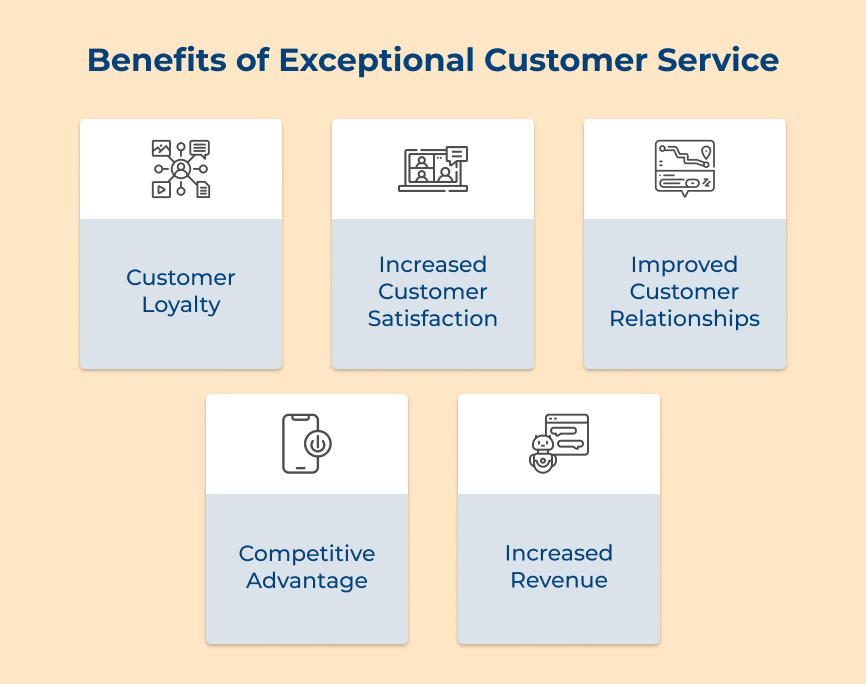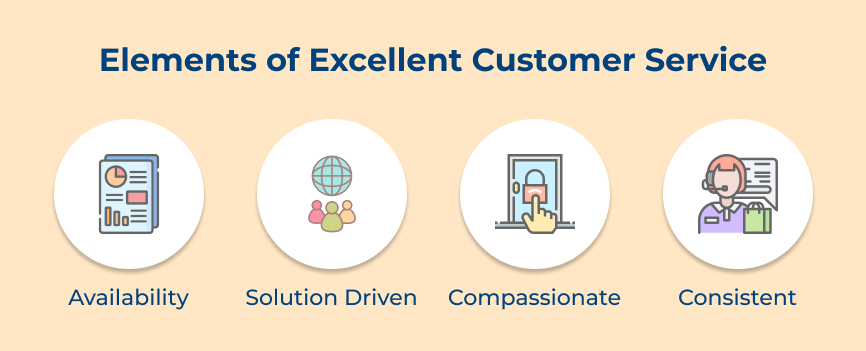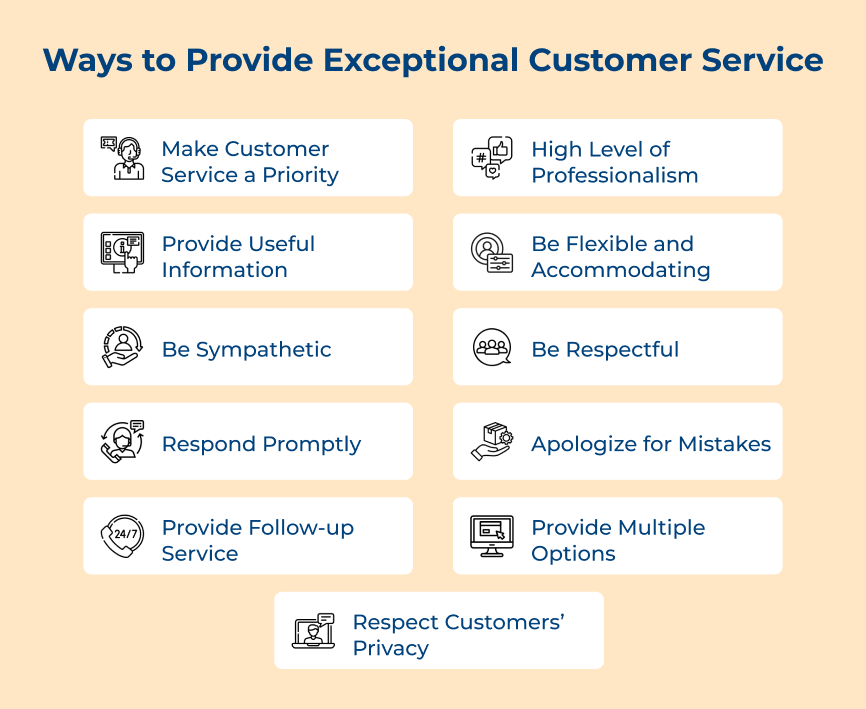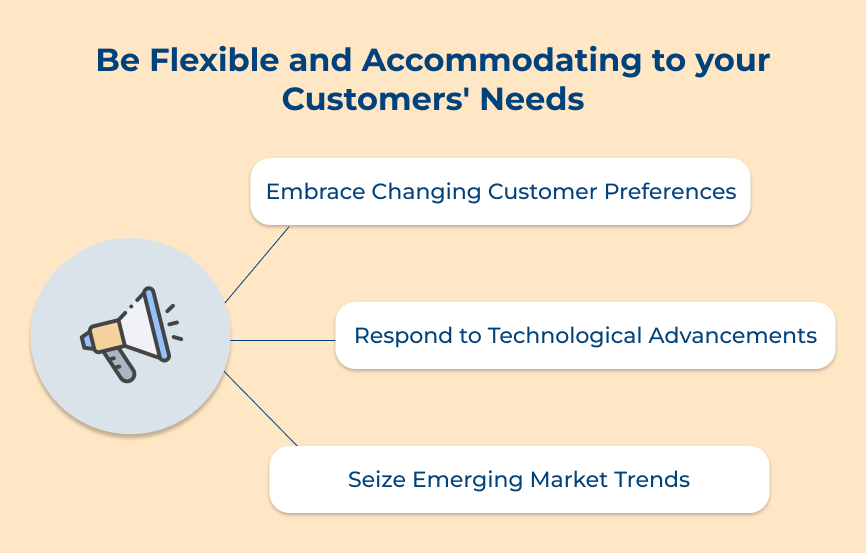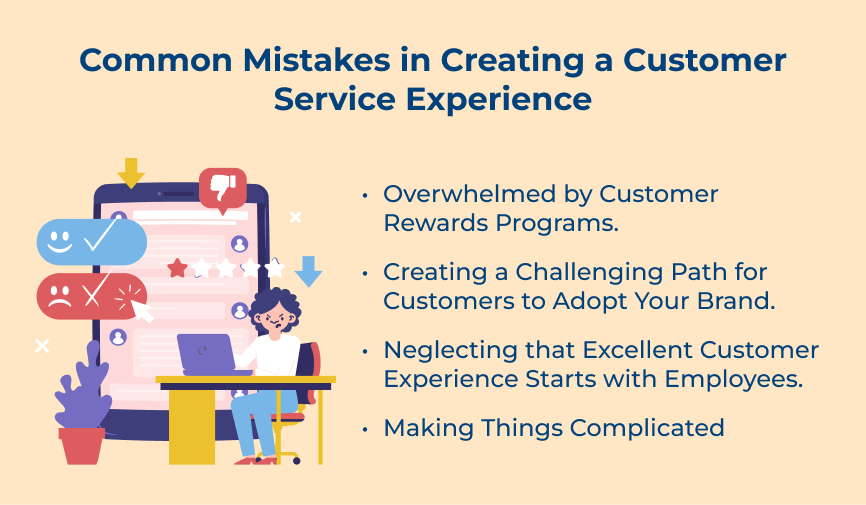- A customer has a last-minute request for a product or service. Being flexible or accommodating allows the brand to prioritize their order and ensure timely delivery.
- A consumer has specific preferences or specifications for a product. Accommodating their needs allows the brand to tailor its offering to meet their exact requirements.
- A customer encounters an issue or challenge. Being flexible and proactive in finding a solution allows the brand to turn a negative experience into a positive one.
- A client has a unique request or requirement that falls outside the norm. Being open-minded and creative allows the brand to find innovative ways to meet its needs.
The main challenge of being flexible or accommodating is finding a balance between meeting customer needs and maintaining operational efficiency. It can be challenging to make exceptions and accommodations while still upholding company policies or standards.
Best practices:
- Communicate transparently with customers about what is possible and what is not.
- Empower the employees to make decisions and find solutions that best serve the customer.
- Continuously gather feedback and adjust the approach to better meet customer needs.
5. Be Sympathetic to the Customer’s situation
Being sympathetic to the customer’s situation is a key strategy in providing exceptional customer service. The approach involves understanding the customer’s emotions and showing empathy towards their needs or concerns. When the brand is sympathetic to the customer’s situation, it is more likely to listen actively and respond with genuine care and understanding.
Let’s take an example of a customer who is facing financial difficulties and is unable to pay their bill on time. A sympathetic response could involve offering a payment plan or a discount to help alleviate their stress.
Best practice:
- Use language that shows empathy such as “I understand how frustrating this situation must be for you.”
- Offer solutions that take the customer’s circumstances into account, showing that the brand cares about their well-being.
6. Be Respectful of the Customer’s Time and Money
One essential strategy to provide exceptional service is to be respectful of the customer’s time and money. It means valuing their resources by providing efficient and cost-effective solutions to their needs. Respecting the customer’s time or money allows businesses to create a positive and trusting relationship with their clientele. The strategy can also result in repeat business or positive referrals.
Failing to respect the customer’s time and money can lead to dissatisfaction or frustration. It can result in lost revenue and damage to the business’s reputation. Let’s take an example of a customer who is waiting for an extended period or is charged unreasonable fees for a service. They may feel taken advantage of and choose to seek services from a competitor instead.
Pro tips:
- Provide timely responses to customer inquiries and issues.
- Offer transparent pricing and value for money.
- Streamline processes to minimize wait times and maximize efficiency.
7. Be Prompt in Responding to the Customer’s Queries
Being prompt in responding to the customer’s queries is a crucial strategy for providing exceptional customer service. When customers reach out with questions or concerns, they expect timely responses to address their needs and provide the assistance they are seeking. The strategy not only shows the customers that value their time or concerns but it also helps in building trust and loyalty with them.
Let’s explore an example of a customer reaching out to a company with a question about a product they purchased. The customer’s experience may be tainted and they may be less likely to return for future purchases if the company takes days to respond. When the company responds promptly or resolves the issue efficiently, the customer is more likely to feel satisfied and continue to support the business.
Pro tips:
- Use automation tools to set up quick response templates for common inquiries.
- Monitor customer service channels regularly to ensure no query goes unanswered.
- Train the customer service team to prioritize prompt responses and provide timely solutions to customer issues.
8. Apologize if you have made a mistake or failed to deliver on your promise
Apologizing if the business has made a mistake or failed to deliver on the promise is a crucial strategy in providing exceptional customer service. One common mistake for which the brand might need to apologize is delivering a product or service late.
Let’s take an example of the brand promising a customer that their order would arrive within a week but it is delayed due to unforeseen circumstances. Apologizing and offering a solution can help salvage the situation.
Pro tips:
- Offer a sincere apology and take responsibility for the error: Avoid making excuses or blaming others, as this can come across as insincere.
- Take action to make it right: Offer a discount, a refund or an expedited solution to the problem. Showing that the brand is committed to rectifying the mistake can go a long way in rebuilding trust with the customer.
9. Provide excellent follow-up service, even after the sale is completed
Providing excellent follow-up service, even after the sale is completed is crucial in building strong customer relationships and ensuring customer satisfaction. The strategy involves reaching out to customers post-sale to ensure their needs are met, address any concerns and promote loyalty.
Following up with customers after a sale allows businesses to show that they care about their customers and value their feedback. It helps in providing exceptional customer service as it builds trust, encourages repeat business and can lead to positive word-of-mouth referrals.
There are various follow-up methods that businesses can utilize such as:
- Sending personalized thank you emails.
- Conducting satisfaction surveys.
- Providing ongoing support and assistance.
- Offering exclusive deals to returning customers.
Let’s take an example of a clothing store that may follow up with customers after purchase. Sending a personalized email with styling tips or offering a discount on their next purchase. It not only shows appreciation for the customer’s business but also encourages them to return for future purchases.
Best practice:
- Personalize tthe follow-up communication by addressing customers by name and referencing their specific purchase.
- Use follow-up even after purchase to understand customer feedback and improve the service for the future.
- Use follow-up interactions as an opportunity to upsell or cross-sell additional products and services that may be of interest to the customer.
10. Provide the customer with multiple options
Businesses must give customers multiple options to choose from to provide exceptional customer service. Offering a variety of options allows the brand to show that it is attentive to their needs and willing to go the extra mile to meet their expectations. The strategy helps in providing outstanding customer service by allowing customers to personalize their experience and choose the option that best suits them.
Let’s take the example of a clothing retailer who could provide customers with the option to choose between standard shipping, express shipping or in-store pickup. The flexibility allows customers to select the shipping method that aligns with their schedule and the urgency of receiving their items.
Pro tips:
- Regularly update and expand the range of options to keep up with changing consumer trends or demands.
- Communicate clearly with customers about the various options available to them, ensuring they are aware of all the choices at their disposal.
11. Respect the privacy of your customers by not sharing information with others
Respecting the privacy of the customers is key to providing exceptional service. When the brand respects the privacy of its customers, the brand is demonstrating that it takes their confidentiality seriously. It leads to increased customer loyalty and satisfaction, as they feel comfortable sharing their personal details with the company.
Let’s take an example of a customer who may provide sensitive information such as their address or credit card details, while making a purchase. Keeping this information private and secure allows the brand to show that it is trustworthy and reliable. Leading to a positive customer experience.
Pro tips:
- Implement strict privacy policies and procedures to ensure that customer information is kept confidential.
- Train the employees on the importance of privacy and the proper handling of customer data.
- Regularly review or update the privacy practices to stay compliant with any regulations and to maintain customer trust.
Real Examples of Brands Providing Exceptional Customer Service
Here we will explore real-life examples of brands that have set the standard for exceptional customer service. These companies have demonstrated a commitment to putting their customers first, from personalized interactions to quick problem resolution.
1. Zappos
Zappos is an online shoe and clothing retailer known for its exceptional customer service. The company has built a reputation for going above and beyond to create a positive shopping experience for its customers. One of the key strategies Zappos has implemented to provide outstanding customer service is its 24/7 customer service line.
Zappos has a generous return policy, allowing customers to return items for up to a year after purchase. Zappos’ commitment to outstanding customer service has resulted in a loyal customer base and positive word-of-mouth marketing.
2. Amazon
Amazon is an e-commerce giant that offers a wide range of products and services. The company is known for its fast shipping, easy returns and excellent customer service. Amazon has implemented several strategies to provide exceptional customer service.
The company also offers a customer service chatbot, allowing customers to easily resolve any issues they may encounter. Amazon’s focus on outstanding customer service has helped the company maintain its position as a leader in the e-commerce industry. They experienced increased customer loyalty, repeat purchases and positive reviews.
3. Ritz-Carlton
Ritz-Carlton is a luxury hotel chain known for its exceptional customer service and attention to detail. The company prides itself on providing a personalized and memorable experience for each guest. One of the key strategies Ritz-Carlton has implemented to provide outstanding customer service is its “Gold Standards.”
These standards outline the company’s commitment to creating unique and memorable experiences for guests. Including personalized greetings, anticipatory service and swift problem resolution. Ritz-Carlton’s focus on outstanding customer service has led to high customer satisfaction rates, positive reviews and a strong reputation.
4. Nordstrom
Nordstrom has built a reputation for its exceptional customer service by offering a generous return policy and personalized shopping experiences. Their strategy revolves around creating a seamless shopping experience with a focus on building long-term relationships with customers. The commitment to exceptional service has resulted in increased customer satisfaction, higher sales conversions and a strong brand reputation in the retail industry.
5. Southwest Airlines
Southwest Airlines is known for its exceptional customer service and friendly staff. The airline has implemented a strategy of putting customers first, with a focus on transparency, flexibility and responsiveness.
Southwest offers perks like no change fees, two free checked bags and a customer-friendly cancellation policy. All of which contribute to a positive customer experience. The focus on customer service has had a positive impact on Southwest’s business.
Common Mistakes in Creating a Customer Service Experience
Creating an exceptional customer service experience is crucial for the success of any brand. There are common mistakes that brands make that can hinder their ability to deliver outstanding customer service. Let’s take a look at some of these mistakes:






